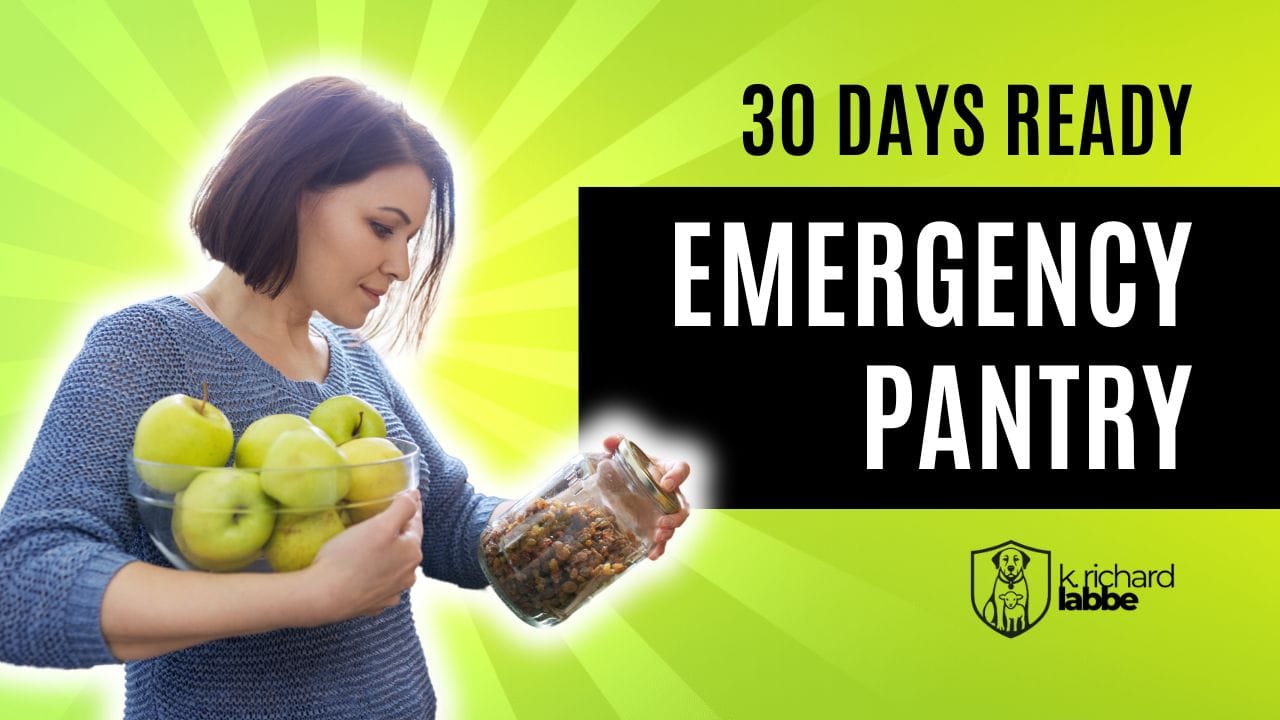30 Days Ready: How to Build a Real-Life Emergency Pantry Without Panic or Prepping Out
A well-stocked emergency pantry creates calm in life’s literal and figurative storms. It lets you care for your people with quiet confidence—so you’re not the one racing to the store when things go sideways.

You don’t need to stockpile like it’s the end of the world.
But you do need a little breathing room.
Not just for once-in-a-lifetime disasters, but for the disruptions that show up when we’re already worn thin. I’ve lived through a few of those.
As a kid growing up in the Northeast, I remember the way a blizzard could shut everything down without warning. Roads impassable. Stores closed. Power lines down for days. We ate what was in the house—and if it wasn’t there, we went without. As an adult, I’ve watched hurricane winds tear through communities and leave people scrambling for basic supplies. And then, of course, we all lived through the early days of the COVID pandemic—the empty shelves, the eerie quiet, the sudden realization that supply chains and safety nets aren’t as sturdy as we thought.
Now we’re facing a different kind of uncertainty. The recent flare-up with Iran reminds us how quickly global events can ripple into our everyday lives—fuel prices, shipping delays, food costs. Add in cyber threats, power grid vulnerabilities, and economic instability, and it’s clear: a well-stocked pantry isn’t about fear. It’s about wisdom.
It creates calm in life’s literal and figurative storms. It lets you care for your people with quiet confidence—so you’re not the one racing to the store when things go sideways.
Let’s get you 30 days ready. One shelf, one step, one wise decision at a time.
Why 30 Days?
Three days of supplies used to be the recommendation. These days, it’s barely a start.
Extended power outages, supply chain slowdowns, and long-term weather events have all shown us that emergencies don’t always resolve quickly. A 30-day pantry gives you some nice margin. It gives you options. And it buys you time—so you can think clearly, care for others, and stay steady under pressure.
No bunkers required. Just a bit of planning and the willingness to start.
What Are We Preparing For?
Here’s the reality: most disruptions won’t make national headlines. But they’ll affect your daily life all the same.
- Storms and hurricanes
- Grid failures (ice, wildfire, system overloads)
- Shipping delays and supply gaps
- Cyberattacks or infrastructure failures
- Instability overseas (like recent U.S.–Iran conflict)
- Quarantine periods or illness waves
- Layoffs, benefit delays, or inflation spikes
What to Stock for 30 Days of Steady Living
Let’s keep this simple, doable, and realistic.
1. Food You Actually Eat
Start with meals you already make—and build from there. We've included affiliate links to products on Amazon for your convenience.
Shelf-Stable Staples:
- Rice, oats, pasta, instant potatoes, grits (affiliate link)
- Dried or canned beans (affiliate link)
- Shelf-stable milk (boxed, powdered, or evaporated) (affiliate link)
- Canned meat (tuna, chicken, salmon, Spam) (affiliate link)
- Peanut butter and nut butters (affiliate link)
- Canned veggies (green beans, corn, tomatoes) (affiliate link)
- Canned fruits (peaches, pineapple, applesauce) (affiliate link)
- Broth, soups, chili, pasta sauce
- Baby food or formula, if needed (affiliate link)
Comfort and Variety:
- Crackers, trail mix, protein bars (affiliate link)
- Hard candy, gum, chocolate (affiliate link)
- Drink mixes (tea, coffee, electrolytes) (affiliate link)
- Honey, spices, hot sauce, condiments (affiliate link)
- Baking basics (flour, sugar, yeast, baking powder)
Food Prep Tools:
- Manual can opener (affiliate link)
- Cast iron skillet or camping pot (affiliate link)
- Camp stove or grill with fuel (affiliate link)
- Aluminum foil (affiliate link)
- Disposable plates/utensils (affiliate link)
- Zip-top bags (affiliate link)
- Plastic wrap (affiliate link)
2. Water: Store Some, Plan to Treat the Rest
Water needs add up fast—aim for one gallon per person per day, minimum.
Storage Tips:
- Fill and rotate clean juice or soda bottles (not milk jugs)
- Keep bottled water in flats or bins
- Label containers with fill dates
Treatment Options:
- Water filters (Berkey, Sawyer, Lifestraw) (affiliate link)
- Plain bleach (unscented) for disinfection
- Water purification tablets (affiliate link)
Even if you can’t store 30 days’ worth, having a way to make water safe is essential.
3. Health, First Aid, and Medications
Emergencies get harder fast when you're unwell—or can’t access basic care.
- 30-day supply of prescription medications
- Pain relievers, cold/allergy meds, antacids, laxatives (affiliate link)
- First aid kits and supplies (bandages, antiseptic, gauze, gloves, tweezers, etc.) (affiliate link)
- Extra glasses or contact lens supplies
- Medical info and medication list (printed)
If anyone in your home has a chronic condition, talk with their provider now about contingency plans.
4. Power, Lighting, and Heat
When the lights go out, you'll want options.
- Flashlights and headlamps (hands-free is helpful) (affiliate link)
- Extra batteries (check sizes) (affiliate link)
- Battery banks or solar phone chargers (check connection type) (affiliate link)
- Propane lanterns or emergency candles (used with care) (affiliate links)
- Camp stove or grill for boiling water/cooking (used with care) (affiliate link)
- Firewood, propane, or other fuel—if safely stored and used (affiliate link)
If you rely on electric medical devices or refrigerated medications, look into backup power solutions before the need is urgent.
5. Cleaning and Hygiene
You won’t regret having backups of these:
- Toilet paper, paper towels, baby wipes (affiliate links)
- Hand soap, dish soap, laundry detergent (pods last well) (affiliate links)
- Toothpaste, toothbrushes, deodorant (affiliate links)
- Feminine hygiene products (affiliate link)
- Trash bags (for waste and water collection) (affiliate link)
- Diapers, adult incontinence supplies (if needed) (affiliate links)
Even small comforts—like lip balm or dry shampoo—can help a hard week feel more manageable (affiliate links).
6. Care for Special Needs
Tailor your pantry and supplies to your people.
- Spare walker tips, cane grips, or hearing aid batteries
- Communication boards or sensory tools
- Pet food, leashes, meds, and carriers
- A few shelf-stable meals your picky eater will accept
One size does not fit all. Plan for the actual faces in your home.
7. Boredom Busters and Morale Boosters
A stocked pantry keeps people fed. But you also need to help them stay well.
- Books, puzzles, board games, card decks (affiliate link)
- Coloring supplies (great for kids and anxious adults) (affiliate link)
- A journal and pens (affiliate link)
- Bible or devotional (printed)
- A few "only for emergencies" treats to lift spirits
Keeping boredom and tension low matters—especially during prolonged outages or confinement.
8. Key Documents and Communication
When the internet’s down or your phone dies, paper still works.
- Printed copies of IDs, insurance cards, prescriptions
- Emergency contacts written down
- A small amount of cash (in small bills)
- Fireproof box or waterproof folder
Think through what you’d need to prove who you are or what’s yours—without digital access.
9. Build With Others in Mind
A prepared person is a gift to their community.
- Keep a little extra food or hygiene items for someone in need
- Have a backup plan for elderly neighbors or out-of-town relatives
- Be someone others can count on—not someone caught unprepared
You’re not just prepping for yourself. You’re planting peace for others too.
Where to Start Today
If this feels like a lot, that’s okay. The best way forward is just to begin.
Consider trying this:
- Buy a flat of bottled water
- Pick up a bag of rice, canned soup, and peanut butter
- Check your flashlight and grab a manual can opener
- Write down your emergency contacts
- Ask: “If I couldn’t shop for four weeks, what would I miss?”
That’s it. One shelf at a time. We’re building peace, not panic.
A Final Word
You don’t need to do it all at once.
But you can do this—wisely, patiently, and with love.
A prepared pantry isn’t just about getting through hard times. It’s a quiet way of saying to your family, “You’re safe here.” It’s a gift you give your future self—and a way to be ready when a friend, neighbor, or loved one suddenly needs help.
This kind of steady, thoughtful readiness is one of the simplest, most tangible ways we can care well for others.
Next up: the 60-Day Pantry Plan—how to stretch what you have, store without a basement, and prepare for others as well as yourself.
Until then… be prepared, never paranoid.
Stay safe. Be ready. Online and off.
Every effort has been made to ensure the accuracy and reliability of the information presented in this material. However, Labbe Media, LLC does not assume liability for any errors, omissions, or discrepancies. The content is provided for informational and educational purposes only and should not be considered professional advice. Viewers are encouraged to verify any information before making decisions or taking actions based on it.
As an Amazon Associate, I earn from qualifying purchases. This comes at no extra cost to you and helps support the work of this site. Thank you!
